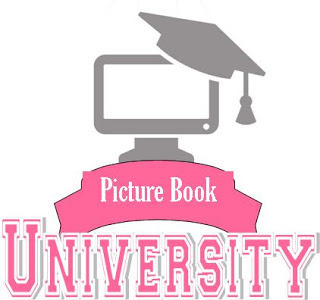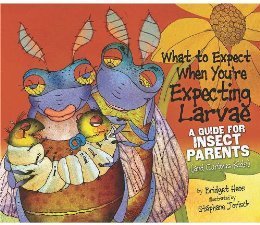Picture Book University: Creative Nonfiction

Today I'm going to go over a genre that allowed me to receive that first picture book contract, and it's something my agent has said editors want--creative nonfiction. Because of the new Common Core Standards that most states have adopted, teachers are now clamoring for books in science and history that can be taught using literature. Science is a biggie since in the Common Core, any science in the elementary grades will be taught through the reading program. History/social studies will be taught that way as well, so this could be a huge boon for publishers who are smart enough to produce books that help teach those subjects. And that means, YOU, dear author, can also start writing books that will help educate our little ones.
But what if you're like me and the thought of writing a nonfiction book leaves your mouth dry like a piece of moldy toast? That's where CREATIVE nonfiction can actually fulfill your need to write something with pizzazz AND also reward you with that coveted picture book contract. If you're smart, you'll do some digging on what exactly you'd like to "teach" creatively.
What is creative nonfiction exactly? It's a nonfiction subject that is told or shown in a creative way. In order to discuss this further, I'll show some categories and examples to get your juices flowing.
 Teaching a nonfiction topic through a fictional story--The focus here is on a fiction tale that hones in on the nonfiction subject--and the nonfiction subject must be the star of the book. In Charlesbridge's math adventure line, highly sophisticated math subject matter is conveyed through exciting stories. When I set out to write a math adventure, I studied all of their books to get the idea. Math had to not just be a bunch of set problems--it had to be almost a character in itself. For my first book, Multiplying Menace, the magic in the story WAS the math! One author to check out for creative nonfiction titles is Trisha Speed Shaskan. Her music families series titles are genius. She tells a story of a certain "type" of instrument family all the while teaching about the different musical instruments and sounds. This kind of story could be done on any subject. She also has other creative nonfiction books. Check them out! Teaching a nonfiction topic through a surprising format--Apart from the hum drum, this type of book uses an idea and runs with it creatively. One example is the book, What to Expect When You're Expecting Larvae. It's told as a self help book for expecting bug parents. Within the pages conveys a lot of buggy facts that makes this
Teaching a nonfiction topic through a fictional story--The focus here is on a fiction tale that hones in on the nonfiction subject--and the nonfiction subject must be the star of the book. In Charlesbridge's math adventure line, highly sophisticated math subject matter is conveyed through exciting stories. When I set out to write a math adventure, I studied all of their books to get the idea. Math had to not just be a bunch of set problems--it had to be almost a character in itself. For my first book, Multiplying Menace, the magic in the story WAS the math! One author to check out for creative nonfiction titles is Trisha Speed Shaskan. Her music families series titles are genius. She tells a story of a certain "type" of instrument family all the while teaching about the different musical instruments and sounds. This kind of story could be done on any subject. She also has other creative nonfiction books. Check them out! Teaching a nonfiction topic through a surprising format--Apart from the hum drum, this type of book uses an idea and runs with it creatively. One example is the book, What to Expect When You're Expecting Larvae. It's told as a self help book for expecting bug parents. Within the pages conveys a lot of buggy facts that makes this
 topic funny, accessible, and entertaining. Another series of books that's told in a surprising way is the If You Were a _____ (fill in the blank). Some examples of these books are If You Were a Quadrilateral, If You were a Fraction, If You Were a Compound Word, etc. These books creatively use the child as the star and has them imagine themselves as the actual nonfiction topic. Very clever. Another knock out surprising format is using a parody--Lane Smith's, John, Paul, George & Ben, nails the creative nonfiction genre. He uses the Beatles as an underpinning analogy to our United States founding fathers. Parents are pleased with the references and kids are pleased by the silliness. That's a great one to check out.
topic funny, accessible, and entertaining. Another series of books that's told in a surprising way is the If You Were a _____ (fill in the blank). Some examples of these books are If You Were a Quadrilateral, If You were a Fraction, If You Were a Compound Word, etc. These books creatively use the child as the star and has them imagine themselves as the actual nonfiction topic. Very clever. Another knock out surprising format is using a parody--Lane Smith's, John, Paul, George & Ben, nails the creative nonfiction genre. He uses the Beatles as an underpinning analogy to our United States founding fathers. Parents are pleased with the references and kids are pleased by the silliness. That's a great one to check out.
 Teaching a nonfiction subject through rhyme/meter--This is a favorite in the trade/school market. If you can use great meter or rhyme to teach a subject, then it will sell. Some glorious classic examples are Math Curse, Science Verse by Jon Sciescka, Grapes of Math series by Greg Tang, and Verla Kay's metered verse history books. One of my critique partners just sold a book that was told in rhyme that highlighted a historical parade. You never know! If you can think up a great subject and you can write rhyme well, go for it!
Teaching a nonfiction subject through rhyme/meter--This is a favorite in the trade/school market. If you can use great meter or rhyme to teach a subject, then it will sell. Some glorious classic examples are Math Curse, Science Verse by Jon Sciescka, Grapes of Math series by Greg Tang, and Verla Kay's metered verse history books. One of my critique partners just sold a book that was told in rhyme that highlighted a historical parade. You never know! If you can think up a great subject and you can write rhyme well, go for it!Assignment 8:
Go to the library and see if some of these examples are there. Are they in the nonfiction section or fiction? I've found librarians don't know where to place them. My books are often in both, but usually in nonfiction so teachers and students will have access to them when finding a subject. Ask your librarian if they know of other examples. Some other authors to look up are Robin Pulver, Loreen Leedy, and Brian P. Cleary. Check out as many as you can of various subjects that inspire you. Can you find different formats? One of each (story, surprising format, rhyming text)?Next, brainstorm at least three new ideas in your writing journal. If one calls to you, start your research and then write!
Did you find a book that didn't fit my definitions or know of a great book to check out? If so, please share!
If this post helped you, please share by clicking the twitter bird, fb like, or google plus!
Missed a few PBU posts? Click here: PBU
Published on September 10, 2013 09:36
No comments have been added yet.



